

 The South African
The South African
This article is published in two parts. The first part appeared in Military History Journal, Volume 16 No 2, December 2013. This is the second part, which includes the full bibliography and an appendix listing all surviving ordnance, machine guns and gun carriages of the British South Africa Company.
Editor's note: Owing to a typographical error in the last issue of the journal, the date of this issue of the journal was incorrectly given as June 2013 in reference to the appearance of the second part of this article (p 50, MHJ Vol 16 No 2, December 2013). The correct date of publication is, of course, June 2014. The Editor apologises for this error.
ARMAMENTS ACQUIRED BY THE COMPANY IN 1895
In January 1895 Jameson purchased large quantities of arms in England, ostensibly to arm a new volunteer regiment known as the Rhodesia Horse, but almost certainly in preparation for his later invasion of the Transvaal. Not surprisingly, what he bought has never been made public but a fair estimate of the number and type of heavy weapons that were included in the purchase can be made by a comparison of the numbers of arms known to have been in Rhodesia in 1893, as identified in the preceding paragraphs (see Part One), with those Jameson is known to have left in Rhodesia and Bechuanaland in December 1895 and surrendered to the Zuid-Afrikaansche Republiek in January 1896.
In January 1896 Jameson surrendered to the Transvaal authorities a 12 ½ pdr QF Maxim-Nordenfelt field gun and six 0.303 cal Maxim guns. The men of the Bechuanaland Border Police (BBP) who volunteered to accompany Jameson into the Transvaal had two of their own 7 pdr RML guns on Kaffraria field carriages and two 0.45 cal Maxims on galloping carriages; these arms, which were also surrendered, had all become the property of the Company when it had been vested by the British Government with the administration of the border districts of the Bechuanaland Protectorate earlier in 1895.
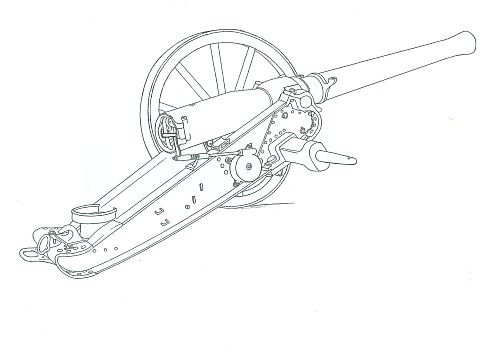
When he left for the Transvaal, Jameson had left at Bulawayo the following: one new 12 ½ pdr QF Maxim-Nordenfelt field gun barrel (its carriage had not been delivered in time); one new 2.5 inch RBL jointed gun; two new 0.303 cal Maxim guns; one 'Portuguese' 2.5 in RML gun; one 7 pdr RML gun;one 'Portuguese' 37 mm QF Hotchkiss gun; one 'Portuguese' 0.45 cal Nordenfelt gun; one 0.45 cal Gardner gun; and one 0.45 cal Gatling gun.
In Mashonaland, he had left: two new 'Extra Light' 0.303 cal Maxim guns at Salisbury; one 7 pdr RML gun at Umtali; one 1 pdr Maxim-Nordenfelt gun at Salisbury; one 'Portuguese' 37 mm QF Hotchkiss gun at Victoria; one 'Portuguese' 0.45 cal Nordenfelt gun at Salisbury; and six 0.45 cal Maxim guns, of which three were at Salisbury and three at Victoria.
Late in 1895 one 7 pdr RML gun on a Kaffraria field carriage, a 2.5 in RML gun and two 0.45 cal Maxims on galloping carriages, all of which had previously belonged to the BBP, had been left by the police at Fort Matlaputla to await reallocation by the Company. Taking into account all the figures given above, a reasonable estimate of the heavy arms purchased by Jameson in 1895 is as follows: two 12 ½ pdr QF Maxim-Nordenfelt field guns with limbers, one taken to the Transvaal and the barrel of the other left at Bulawayo; one 2.5 in RBL jointed gun on a mountain carriage, left at Bulawayo; six 0.303 cal Maxim guns, on galloping carriages, taken to the Transvaal; two 0.303 cal Maxim guns, apparently only with tripods, left at Bulawayo; and two 0.303 'Extra Light' Maxim guns, only with tripods, left at Salisbury.
The 12 ½ pdr QF Maxim-Nordenfelt field guns, which used fixed ammunition, were of an advanced design with single motion breech blocks and a field carriage fitted with a hydro-pneumatic recoil control system. (The carriage for the 12 ½ pdr QF Maxim-Nordenfelt barrel Jameson left at Bulawayo eventually arrived there towards the end of 1896. The gun was used by the British South Africa Police during the Anglo-Boer War.) The 2.5 in RBL jointed gun was a relatively simple but not very satisfactory breechloading conversion of the standard 2.5 in RML jointed mountain gun.
The six 0.303 cal Maxims Jameson took to the Transvaal all had carriages, as did the two he left at Bulawayo, but it is clear from reliable contemporary drawings that these were not the usual galloping carriages but consisted of a light steel pole trail fitted with a shield, axle and 3 ft diameter wheels; they required a small limber for draught. This type of carriage was issued to the Royal Navy but was not adopted for the British Army. After the use of one of the new 0.303 Maxims near Bulawayo on 25 April 1896, it was remarked that it 'ran well, but not so well as the older .45 Martini pattern' (BSACo Report p 37). This suggests that the gun was not one of those manufactured as a 0.303 cal weapon, but a conversion of a 0.45 cal one, the action of which did not operate as smoothly as that of the original 0.45 cal gun. The reason for this was that the converted gun retained the heavier mechanism of the 0.45 cal one and so needed to be fitted with a muzzle 'Ball Firing Attachment'to boost the recoil effects, without which the gun would not work at all.
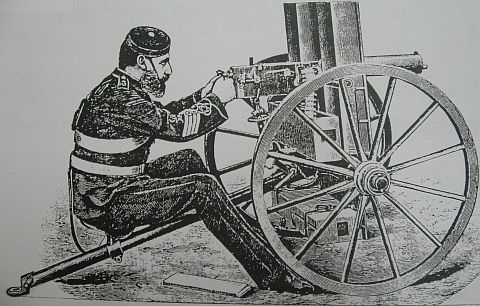

The two 'Extra Light' 0.303 cal Maxims that Jameson left at Salisbury were air cooled guns without the heavy bronze water jackets of the standard models. They were not very satisfactory weapons because the cooling arrangements did not work well and the guns overheated and became dangerous to use after the continuous firing of as few as 400 rounds, which could be done in under a minute; the gun was never adopted for the regular British Army. At least one of the guns was sent to Gwelo in 1896 but neither of them appear ever to have been used in action.
ARMAMENTS ACQUIRED BY THE COMPANY IN 1896
The numbers of arms that Jameson took to the Transvaal and those he left in Rhodesia and Bechuanaland, as suggested in the preceding paragraphs, have been calculated from records left by a number of authorities, not the least being Maj H Plumer and F C Selous. (Acting on orders of the Colonial Office in London, Plumer had gone to Bulawayo early in 1896 to take possession of the Company's arms and thereby prevent them from being used against the Zuid-Afrikaansche Republiek.) However, there is one area where Plumer and Selous appear to disagree, namely the number of 7 pdr RMLs and Maxims in Bulawayo in March 1896.
In February 1896 Plumer recorded that, in his area of responsibility, which included not only the Bulawayo area but that part of Bechuanaland that had recently been placed under the administration of the Company, there were two 0.303 cal Maxims, two 0.45 cal Maxims and four 7 pdr RML guns. However, while Selous confirmed the existence of the two 0.303 cal Maxims at Bulawayo on 23 March 1896, he made no mention of any 0.45 cal Maxims and recorded only one 7 pdr RML gun at the town when the Matabele Rebellion began on that day. He added that the 7 pdr was useless outside Bulawayo because white ants had destroyed its carriage. He must have meant that the wheels of the gun's limber had been damaged because photographs taken at Bulawayo later in 1896 show two 7 pdr RML guns on original, undamaged, Kaffraria carriages. In any event, the 7 pdr trail and axle, being made of wrought iron, would have defeated the most determined efforts of the termites!
The only explanation for this apparent discrepancy regarding the numbers of 7 pdrs and Maxims must be that Plumer's additional three 7 pdrs and two 0.45 cal Maxims were the surviving guns of the original armament of the BBP, which had been left in the Bechuanaland Protectorate pending their reallocation by the Company. Support for this argument is found in Selous' further record, which states that an additional 7 pdr and the barrel of another, together with two 'old' (that is to say, 0.45 cal) Maxims, arrived in Bulawayo from the post at Macloutsie on 24 March 1896. On Plumer's record this would leave only a fourth 7 pdr RML gun unaccounted for. It seems likely this fourth gun had already been removed to Mafeking, where the BBP had been concentrated in November 1895 prior to the disbandment of that force, and that the gun was still there in March 1896. (It was probably originally allocated to the newly created Protectorate Division of the British South Africa Police in 1897 but appears to have eventually been sent to Rhodesia because in 1974 there were five 7 pdr barrels in that country.)
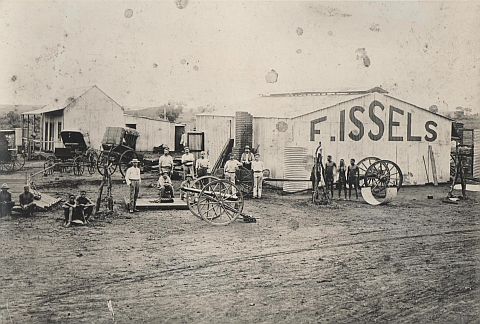
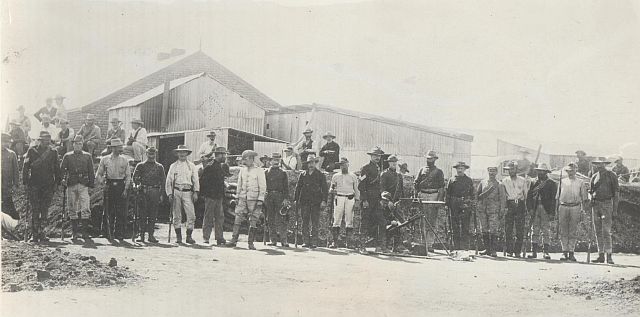

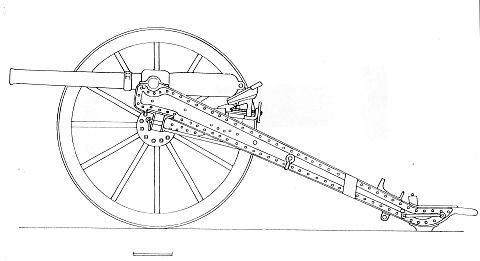
Despite Selous' final record of three 7 pdrs at Bulawayo late in March 1896, there is photographic evidence for only two 7 pdr RML guns with their original Kaffraria carriages at the town during the rebellion. A third 7 pdr was indeed also photographed in Bulawayo in 1896 but it was actually the barrel of a 2.5 in RML jointed mountain gun, which was then often still called a 7 pdr. Since the 2.5 in RML gun, which must have been the barrel that Selous says arrived from Macloutsie on 23 March, did not have its proper carriage, Mr Issels, the foundry owner at Bulawayo, converted the carriage for the Gatling gun to take it. (The Gatling did not then require its carriage because it had been mounted in the defences of the Bulawayo laager on its tripod.)
Why the original carriage for the 2.5 in gun was not sent up to Bulawayo from Macloutsie with the barrel remains uncertain. It may be that, in March 1896, this could not be done because there was then too heavy a demand on the few available draught teams to transport essential supplies to Bulawayo. There is no doubt that a field carriage that could take a 2.5 in RML did eventually arrive in Bulawayo, with its limber, because in 1902 both that carriage and its limber were used to carry Rhodes' coffin to the Matopos Hills. The carriage, which is now in the National Museum at Bulawayo, is one for a 9 pdr RML field gun that had been converted to accommodate both the barrel of a 2.5 in RMLjointed gun and the elevating gear as used with the 2.5 in mountain carriage. It seems certain that this was the missing carriage for the 2.5 in RML gun that had arrived in Bulawayo from Macloutsie on 24 March.
The suppression of the rebellion in Matabeleland required greater military resources than the Company then had in Rhodesia. Fortunately for the settlers, the rebels never attempted to close the principal road southwards from Bulawayo to the Cape. The Matabeleland Relief Force, with more arms, soon arrived in Matabeleland via the Bechuanaland Protectorate without hindrance.
Plumer, who had been appointed to command the Matabeleland Relief Force, had needed a number of machine guns with which to arm his corps. He obtained two 0.45 cal Maxims on naval landing party carriages from the Royal Navy at Simon's Town and bought ten new 0.45 cal Maxims, with tripods only, from a salesman in Durban. He implied that the salesman took a dishonourable advantage of the crisis in Matabeleland to make an unconscionable profit on the sale. (The salesman was almost certainly Mr B Zaharoff, Maxim's so-called 'merchant of death.') The Company retained all twelve of these Maxim guns for its police after their reorganisation as the Rhodesia Mounted Police in late 1896.
During the rebellion in Matabeleland the principal artillery support for the Matabeleland Relief Force was provided by a section of No 10 Mountain Battery, Royal Artillery, sent up from the garrison in Pietermaritzburg. The mountain gunners were equipped with two 2.5 in. RML jointed guns on mountain carriages, complete with all the necessary pack saddles, mules and muleteers. At the time this equipment was the standard armament of Royal Artillery mountain batteries. When the Matabeleland Relief Force had completed its work in Matabeleland at the end of 1896 the Company bought both these guns and all the gun mules, ordnance saddles and related special tools, to provide the main armament for a new artillery troop of the Rhodesia Mounted Police, soon to be renamed the British South Africa Police.


In this article no reference has been made to the events of the Shona Rebellion that also began in 1896 and was not suppressed until the next year. The reason is that no additional ordnance or machine guns were acquired by the Company for the purposes of fighting the rebels there, although one of the 7 pdr RML guns and a 0.45 cal Maxim on a galloping carriage were sent to the province from Bulawayo for use by the local forces. The regular British troops who were sent to Mashonaland to help suppress the rebellion there were armed with their own Maxims and 7 pdr RML guns, but they took these with them when they left Mashonaland at the end of 1896.
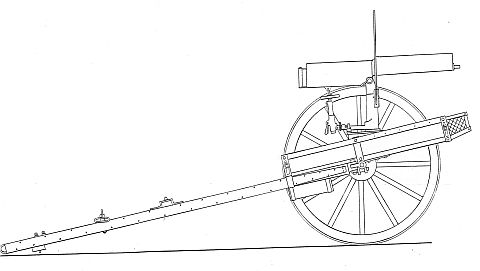
By the end of 1896 the Company had acquired the following additional ordnance and machine guns: two 2.5 in RML guns on mountain carriages, acquired from No 10 Mountain Battery; one 2.5 in RML gun on a 9 pdr field carriage, transferred from the BBP; one 7 pdr RML gun on a Kaffraria carriage, transferred from the BBP; two 0.45 cal Maxim guns on naval landing party carriages, acquired from the Royal Navy; two 0.45 cal Maxim guns on galloping carriages, transferred from the BBP; and ten 0.45 cal Maxim guns on tripods, bought by Plumer.
A summary of all the ordnance and machine guns in the Company's possession at the end of 1896 is as follows:
CONCLUSION
The Company's Charter had reserved for the Secretary of State for the Colonies the right to intervene in the administration of the Company's territories but, until 1896, the exercise of this right, through the High Commissioner at Cape Town, had been confined largely to ensuring that the Company maintained forces sufficiently strong to protect the settlers in Rhodesia from possible attacks by the indigenous peoples.
The Jameson Raid changed that situation dramatically. It was as a result of the involvement of the Company's officials and police in the 'Raid', that the High Commissioner, acting on instructions from the Secretary of State, had sent Plumer to Bulawayo in early 1896 to take control of the Company's armaments remaining both there and in the Bechuanaland Protectorate, on behalf of the Crown. Soon afterwards the High Commissioner replaced the Company's most senior police officer with another regular officer, Col Sir Richard Martin, whom he appointed as commandant general of the Company's police; Martin was primarily responsible to the High Commissioner, not the Company. Once the rebellion in Mashonaland was suppressed in 1897 the High Commissioner, who doubtless believed he could no longer trust the Company to employ its volunteer troops responsibly, ordered the disbandment of the remaining units such as the Rhodesia Horse (Volunteers). In 1898 a Resident Commissioner, responsible to the Crown, was appointed by the Colonial Office with jurisdiction over all military affairs in Rhodesia. The days when the Company's officials could acquire and employ ordnance and machine guns much as they alone thought expedient, were over forever.
APPENDIX: Surviving ordnance, machine guns and gun carriages of the Company
2.5 inch RML Jointed Guns
Drill Hall, Harare: one gun on a Royal Carriage Dept mountain carriage Mk 11*; one gun on an Elswick Ordnance Works mountain carriage*.
Zimbabwe Police Depot gate, Harare: two gun barrels*. 2.5 in RBL Jointed Gun
Drill Hall, Harare: one gun on an Elswick Ordnance Works mountain carriage*.
7 pdr RML Guns
Mutare Museum, Mutare, Zimbabwe: one gun on a Royal Carriage Dept Kaffraria field carriage, with limber.
National Museum, Bulawayo, Zimbabwe: one gun barrel.
Zimbabwe Police Depot gate, Harare: two gun barrels
9 pdr RML Gun Carriage
National Museum, Bulawayo, Zimbabwe: one Royal Carriage Dept carriage converted to mount a 2.5 in RML, with limber.
0.45 cal 5 Barrel Gardner Gun
National Museum, Bulawayo, Zimbabwe: one gun on a Royal Navy field carriage.
0.45 cal Maxim Guns
Mutare Museum, Mutare, Zimbabwe: one gun on a Royal Carriage Dept tripod.
School of Infantry Museum, Gweru, Zimbabwe: one gun on a Royal Carriage Dept tripod.
Brady Barracks, Bulawayo, Zimbabwe: one gun*.
Note: The guns marked with an * were seen by the writer in 1974 at the places indicated but there is no certainty that they are there now.
The Rotunda Artillery Museum, Woolwich, England has a 12 ½ pdr OF Maxim-Nordenfelt Gun on a field carriage that was captured from the Boers during the Anglo-Boer War; it may be the gun lost by Jameson in 1896.
The Mafikeng Museum has two 7 pdr RML guns on Kaffraria carriages, both of which had probably been transferred to the Company from the BBP and later re-allocated to the Protectorate Division of the British South Africa Police.
The Albany Museum, Grahamstown, has a 0.45 cal 5 barrel Nordenfelt machine gun on a field carriage of the same pattern as those taken by the Company from the Portuguese in 1891. Since the garrison at Mafikeng during the Anglo-Boer War is the only military force in South Africa known to have possessed such a gun in the 19th century, the gun may well have come from Mafikeng. If it did the probabilities are that it had belonged to the Company and therefore, was one of the two taken from the Portuguese in 1891.
Note on illustrations
SOURCES
Apart from the sources listed below the writer has also relied on his own collection of contemporary photographs.
BSA Co, Report on the Native Disturbances in Rhodesia (London, British South Africa Co, 1898).
Baden-Powell, Col R S S, The Matabele Campaign 1896 (London, Methuen & Co,1897).
Barnes, J C, 'The Battle of Massi Kessi' in Rhodesiana, No 32, March 1975, p 1.
Bent, J T, The Ruined Cities of Mashonaland (London, Longmans, Green & Co,1896).
Brown, W H, On the South African Frontier (London, Sampson Low, Marston & Co,1899).
Burnham, F R, Scouting on Two Continents (New York, Doubleday, Page & Co,1927).
Darter, A, The Pioneers of Mashonaland (London, Simpkin, Marshall, Hamilton, Kent & Co Ltd, 1914).
Donovan, Capt C H W, With Wilson in Matabeleland (London, Henry & Co, 1894).
Goldsmith, D L, The Devil's Paintbrush, Sir Hiram Maxim's Gun (Toronto, Collector Grade Publications, 1989).
Halkett, C H, 'With Laing in the Matopos' in Rhodesiana No 24, July 1971, p1.
Hall, Maj DD, 'Guns in South Africa 1899-1902' in Military History Journal, Vol 2 No 1, June 1971; Vol 2 No 2, Dec 1971; and Vol 2 No 3, June 1972.
Handbook for the 7-pdr Rifled ML Steel Gun of 200 lbs (London, HM Stationery Office, 1878).
Handbook for the 2.5 inch RML Steel (Jointed) Gun (London, HM Stationery Office, 1888).
Hole, H M, The Jameson Raid (London, Philip Allan,1930).
Hurrell, A, 'The Gwelo Laager 1896' in Rhodesiana No 22, July 1970, P 9.
Johnson, Lt Col F, Great Days (London, G Bell & Sons Ltd,1940).
Konstam, A, The War Rocket in Late Victorian Military Service (Ordnance Society Journal, No 2, p 51).
Ormsby, Capt J B (Ed), Treatise on Military Carriages and other Manufactures of the Royal Carriage Department (London, HM Stationery Office, 1879).
Owen, Capt J F(Ed), Treatise on the Construction and Manufacture of Ordnance in the British Service (London, HM Stationery Office, 1877).
Plumer, Col, H, An Irregular Corps in Matabeleland (London, Kegan Paul, Trench, Truber & Co,1897).
Rhodesian Schools Exploration Society, Macloutsie Expedition Report (Rhodesiana Society, Harare, 1961).
Selous, F C, Sunshine and Storm in Rhodesia (London,Rowland Ward & Co Ltd, 1896).
Shaw, E H J, 'Early Rhodesia's Weapons' in Military History Journal, Vol 1 No 1, Dec 1967, p 31.
Sykes, F W, With Plumer in Matabeleland (London, Archibald Constable & Co,1897).
Treatise on Military Carriages and other Manufactures of the Royal Carriage Department (London, H M Stationery Office, 1895).
Treatise on Military Carriages, Vols I & II (London, H M Stationery Office, 1902).
Tulloch, A, 'Reminiscences' in Zimbabwe Archives, Ref 1/1/1.
Tylden, Maj G, 'Further Notes on Early Rhodesian Military Units and Early Rhodesia's Weapons' in Military His-
tory Journal, Vol 1 No 2, June 1968, p 35.
Tyrie Laing, Maj D, The Matabele Rebellion (London, Dean & Son,1896).
Wahl, P & Toppel, D R, The Gatling Gun (London, Herbert Jenkins, 1966).
Warhurst, P R, 'Extracts from the Letters and Diaries of Victor Morier' in Rhodesiana, No 13, Dee 1965, p1).
Wills, W A & Collingridge, L T, The Downfall of Lobengula (London, The African Review, 1894).
Return to Journal Index OR Society's Home page
South African Military History Society / scribe@samilitaryhistory.org